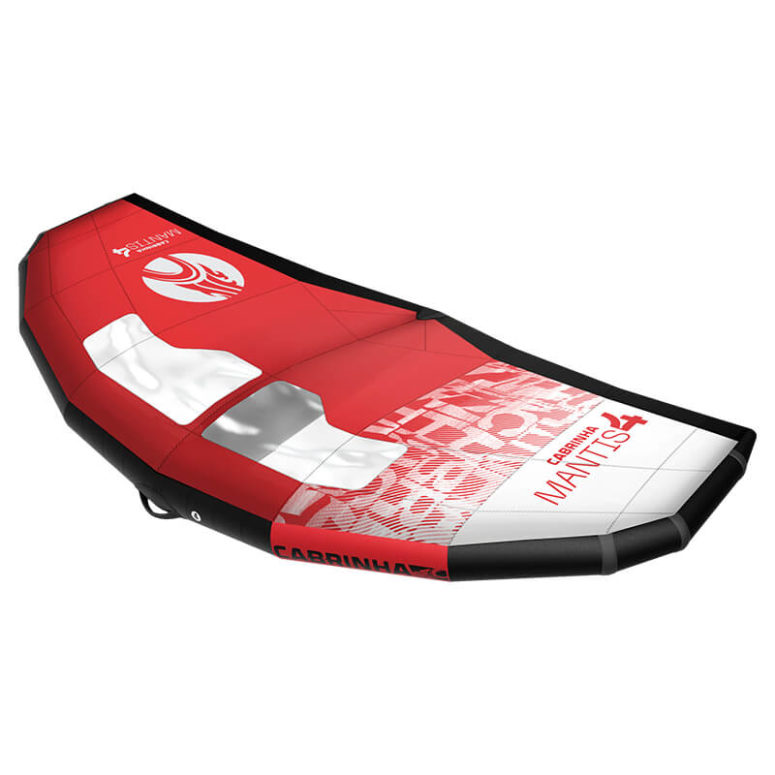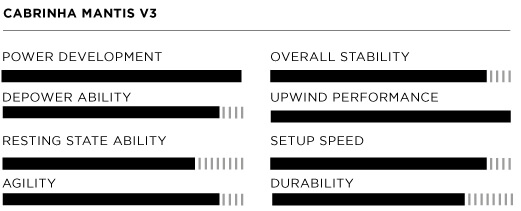

When you purchase gear through links on our site, we may earn a small commission. Here’s why you can trust our tests and our affiliate partner.

It’s been a comprehensive product launch for Cabrinha in 2023, and their existing all-rounder Mantis wing range has had a major overhaul to push its performance and usability even further than before. Sitting alongside the all-new Vision, which is a more forgiving and less grunty wing with a little more dihedral, the Mantis is geared for instant power on sheet and a precise, direct feel without being overly technical to handle. Sizes run from 2m up to a 7m, with half meter increments up to 5m catering for every situation and conditions you could think of.
Off the bat, there’s been some serious upgrades, the most noticeable and tangible of which is the new molded semi-rigid handles, which are an intelligent evolution over the previous model. These comprise of a solid piece of aluminum bar, covered in EVA. The clever bit comes where the handle end spans down and attaches to the strut. This section has a soft rubbery coating and articulated bending almost flat to the strut under load, meaning it won’t ding your board.
The grips are a low diameter avoiding fatigue and arm pump. There are also spacers available which sit under the feet of the strut connection to allow you to tailor how far from the strut you’d like the handle to sit. You can also set this up with one spacer at an angle if you wish. The handles bolt on and off with a T30 Torx fixing, the same as Cabrinha’s hydrofoil fixings. There are two sizes, with the larger handle at the front on the bigger wings for increased trim options upwind and downwind through maneuvers. In practice, the handles make for a refreshingly direct and connected feel with a nice tight pump response, but with a little bit of give if you get a pokey gust; the little bit of flex in them helps temper any potential harshness.
The airframe is noticeably stiffer than previous, with elegantly sculpted layering of material in the center around the strut join and front handle area. The front handle is a reassuringly rigid loop giving you excellent control over any twist in the wing when flagged out on the wave, letting you forget about the wing and concentrate on the business in hand. Through the canopy, a completely different panel layout has been implemented to control any potential deformation better. This has been achieved through locating the seaming in high load areas as well as orientating the ripstop pattern across the load.
The inflation system has had a rework, with twin tubes now feeding air to the strut with neat screw-on valve fixings keeping things very locked in and looking clean. They’ve also tucked in a classic kite dump valve in the strut to make deflation and pack down a little more fuss free. The TPU valves are also frequency welded on to the bladders to make one homogenous form, making them as tough as possible. Lighter bladders have been implemented across the range, and as an example, the 4m weighs in at a competitive 2.22kg.
The Mantis finds a great balance between stability and accessible power, which is noticeable in the excellent low end. It elegantly crosses over between disciplines well. Its more conservative dihedral exposes a large area of sail to the wind, and it drives forward really well, producing plenty of speed and control. The wing never seems to get backed up and stall with wind hitting the topside even under very aggressive sheeting, which can often be the folly of a flatter design; this is a testament to a well-considered profile. In the larger sizes, we were impressed how little fatigue was induced when overpowered. Rather than feel draggy, the Mantis seemed to push upwind and generate speed.
A worthy upgrade over the V2, the new Mantis is going to be the perfect wing to keep the more sportive rider engaged and aid progression in any genre of riding. It remains a balanced, rapid and agile affair which you can throw into any situation and come out smiling. RB
